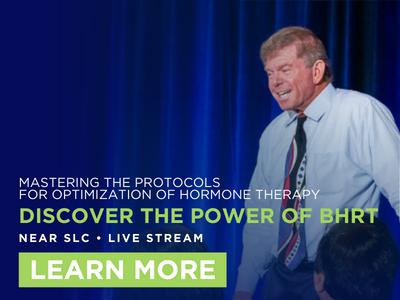
How to Protect Against Collateral Damage
Written by Neal Rouzier, MD

If you are interested in learning more about the value and efficacy of Bioidentical hormones in HRT as an alternative to medication-based therapies, please consider our four part hormone optimization workshop series.
Table of Contents
Introduction
My primary focus will address reversal of DM and CVD. My other focus will address treatment and prevention of cancer. I have spent an entire year amassing hundreds of articles that I felt to be of significant importance for all of us to know and understand. We continue to prescribe medicines that make IR, DM, CVD, and cancer worse, but we ignore the harm due to the therapeutic illusion that the benefits outweigh the risks. Yet we continue to ignore the plethora of data and studies demonstrating how to avoid these risks and protect against DM, CVD, and cancer. The last newsletter ended with articles demonstrating how thyroid optimization can reverse plaque, decrease IMT, improve all lipoproteins, blood pressure, and CVD events. Recommendations were made that within the normal range of thyroid function, levels in the higher range of normal were conducive to CVD protection and low normal levels to increased CVD risk, further emphasizing the need for optimal levels of thyroid in contrast to normal or low normal levels. Despite the plethora of data proving benefits of thyroid hormone in improving all lipid and CVD parameters and reversing plaque, the cardiovascular world ignores this data in favor of utilizing cholesterol-lowering medication instead. Let’s take a final look at benefit vs. risk.
Increased Risk
Statins increase the risk of diabetes, IR, cancer, CAC, dyslipidemia, BMI, and NAFLD. “Yes, but the benefits outweigh the risks.” Nonsense, no they don’t. Yes, they do decrease CVD events by 2-3% ARR. However, what is on the other side of the coin that we miss and ignore? How can we prevent the collateral damage? Testosterone prevents and reverses DM, IR, cancer, CAC, dyslipidemia, BMI, and NAFLD, the opposite of statins. Statins also significantly suppress free and total testosterone levels. So does metformin (I’ll show those studies). So, then, why can’t we give them both together? Could you imagine the pandemonium if testosterone increased CAC, DM, cancer, dyslipidemia, BMI, and NAFLD as do statins? Testosterone reverses all those complications, yet it is completely ignored by the cardiovascular and endocrine world. And statins suppress testosterone levels that make it worse. Assuming the correct type of testosterone is administered, CVD outcomes and plaque reversal are so much better with testosterone than with any cholesterol medication. Yet testosterone is ignored/denigrated whereas cholesterol medications are wonder drugs and life changers. I will review the RCTs demonstrating the ARR reduction of 50-100% with HRT.
But what about the microvascular complications, cancer, and diabetes complications of statins? The benefits do not outweigh the risks according to many experts, the medical literature, and outcome studies and we will review all that data. And all of these harms/complications are reversed with testosterone, E2, DHEA, T3, and GH. The solutions are EBM but ignored. All of the foregoing hormones reduce visceral fat, BMI, DM, and cancer that can reverse the complications of statins, but the studies are ignored or rejected. I’ll present studies that prove the lower the LDL cholesterol from medications, the worse the diabetes and beta cell dysfunction, microvascular complications, and cancer. Statins suppress beta cell function and the lower the LDL, the worse the beta cell dysfunction and apoptosis, and we ignore that data. Our therapeutic illusion only makes us believe what we want to believe, and the brain rejects that which is counter to our beliefs = cognitive dissonance. And it’s so easy to prevent the risks and complications from these medications. Can’t anyone see the elephant in the room? If you see it, why do you ignore it? It is not beyond your scope of practice to optimize hormones if it prevents all the complications of statins.
Why is all the literature rejected and ignored? In addition to statins, various BP meds, SSRIs, antipsychotics, 5-alpha reductase inhibitors, progestins, aromatase inhibitors in men, aromatase inhibitors and tamoxifen in women, megace, and LHRH agonists, all can increase IR and DM risks which account for the increase in CVD in outcome studies. In Part 3 & 4 courses, I presented all the studies and meta-analysis demonstrating statins increase the risk of breast cancer and colon cancer, probably through causing IR and DM which increase the risk of most cancers. Most of this upcoming Beyond Hormones Conference is devoted to the initiation, prevention, and cause of cancer. Dr. Fung and Dr. Bikman will address why cancer treatments don’t work and how cancer becomes resistant to most treatments. It all has to do with insulin, mTOR, AMP-K, and iatrogenic illness that we cause. The benefits of commonly prescribed medicines do not outweigh the risks as we will come to see. However, the risks and harms are easily avoided and reversed. Look, there’s an elephant in the room. Can’t you see it?
The precautionary principle in medicine states that we should do no harm. The foregoing medicines mentioned above all cause harm. In order to rationalize their use, experts claim that the benefits outweigh their harm, and that is what they falsely mislead us to believe as multiple outcome studies prove that claim to be wrong. But we believe these experts that are well-paid to convince us otherwise. On the other hand, there is a plethora of data that prove HRT to be not only safe but can protect against all of that harm of the foregoing medicines, yet it is not utilized as it is misunderstood and misinterpreted. In fact, we’ll review the harm of not using HRT as I have over 600 slides and papers to review.
Statistics
Studies prove that statins increase the risk of diabetes from 10-50%. Yes, but that means that 50-90% of patients don’t get diabetes, so there. However, studies show that dyslipidemia and endothelial dysfunction occur in pre-diabetes, long before diabetes is diagnosed. So, the true harm is missed and ignored if one thinks that there is minimal harm if only 10% develop diabetes. One study demonstrated a 350% increase in DM with long-term use of statins. The insulin resistance and hyperinsulinemia result in significant inflammation, endothelial dysfunction, cancer, and microvascular complications that are not addressed and ignored by the cardiovascular world until full-blown diabetes is confirmed. No wonder why statins and PCSK-9 inhibitors result in an ARR of only 2-3%. Utilizing HRT along with these medications could increase this ARR to > 50%. Unless you have taken the WLM courses, you will remain unaware of these studies.
A worse circumstance is seen in diabetics. Due to the fact that the risk of CVD and mortality is 4 times greater in diabetics, all diabetics receive statins. However, statins do not reduce mortality in diabetics, unfortunately. Remember the long-term studies I presented in the first newsletter that were published in JAMA and the NEJM? Tighter BS control along with statins increased CV events and mortality. The cardio-metabolic world just recommends tighter BS control for the statin-induced diabetes, but this does not prevent the beta-cell dysfunction, microvascular complications, weight gain, increase in BMI, increased mortality and cancer complications seen in these patients. We can’t see the forest for the trees. And all of these risks and complications can be avoided and reversed, yet they are not. What happened to the precautionary principle? Our therapeutic illusion that benefits outweigh the risks has failed us. Then, what else could we do to reap the benefits of the statins and avoid the risks and harm?
The harm of the IR, hyperinsulinemia, systemic inflammation, endothelial dysfunction, dyslipidemia, increase in BMI, and cancer risk can easily be prevented and reversed, and I plan to present all the literature that demonstrates this. We should not wait until diabetes is diagnosed in these individuals, rather we should intervene early on, long before any harm is evident. This is a perfect example of therapeutic nihilism where the cure is worse than the disease. And why are the preventive treatments to reverse the harm ignored? My intent will be to introduce all the medical literature demonstrating all the harm that we cause and ignore. I’ll introduce all the literature demonstrating the treatments to reverse/prevent all the harm that is also ignored or not appreciated. This is all the literature that we should know but do not. And what specialist should be at the forefront in implementing and preventing all the complications as well as preventing and reversing diabetes and CVD? Well, it’s you.
Wrap Up
For those that have attended all the WLM courses, as well as the webinars and journal clubs, you have come to appreciate my favorite topic which is how to read and interpret studies. We try to continue this at each year’s Beyond Hormones Conference. As part of the discussion, I address the limitations of scientific work. Much of the work we rely on, however, is flawed due to many pitfalls. This might leave you coming away thinking that experiments — that is, controlled experiments with randomization — as opposed to observational studies, are foolproof. But this is not the case. Experimental studies frequently suffer from:
- Poor design
- Poor execution
- Poor analysis
- Poor interpretation
- And if that is not enough, even if 1-4 are done correctly, a typically scientifically illiterate media will often layer on their version of some bastardized interpretation in an effort to make the study more appealing to the general population and to us clinicians.
As the result, many studies are poorly interpreted, misinterpreted, extrapolated, and have hidden agendas, biases, and author opinions. Chief editors for JAMA and NEJM have recently quit their positions claiming that 90% of published studies submitted for publication suffer from the foregoing. Sorting through the complexities better enables us to appreciate my most quoted phrase that observation does not prove causation. And secondly, a correlate does not a surrogate make. Evaluating outcome studies, not surrogate markers, leads us to different conclusions. Hopefully, I can better teach you how to evaluate studies. Be skeptical of the evidence and the interpretation in experimental research as it may not always be true.
Best, Neal
